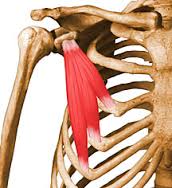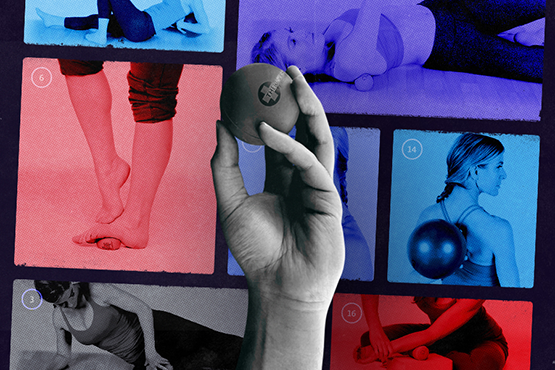
The pectoralis minor is an often problematic muscle that lies deep to its better known companion the pectoralis major. This lovely muscle originates at ribs 3,4, and 5 and inserts on the medial surface of the coracoid process of the scapula. As our modern lives revolve around technology, we find an increased strain on our shoulders from the unnatural rounding stance and forward jutting head created from texting, hunching, and sitting at our keyboards; as such the pectoralis minor is a hot bed of tension and stress just waiting to be loved on and rolled out.

The major action of the pec minor is to stabilize the shoulder blade. More specifically it depresses, abducts, and downwardly rotates the scapula. Along with these actions it also assists in lifting the ribs during forced inhalation (a motion that can be seen in runners’ hard breathing after a race or an asthmatic in the midst of an attack).
As we look around our yoga classrooms at our students moving through the ever popular plank-chatturanga sequences, a common shoulder pattern arises. We see the inferior angle of the scapula lifting up off the ribs causing a ‘winging’ effect to occur. This ‘winging’ is in part due to overzealous pectoralis minors. The combination of shortened pec minors and inhibited serratus anterior leads to this destabilization of the shoulder. Which, over time, through repetitive stress and strain, can lead to shoulder impingement as well as more serious rotator cuff issues. Due to the anatomical placement of the pec minor on top of the brachial plexus (a big bundle of nerves), tightness in this muscle can lead to compression in these nerves and arteries leading to numbness and tingling in the arms.
Using Yoga Tune Up® we can combat our winged yogis with Therapy Ball rolling on the pec minor to encourage the muscle to release and relax, as well as, serratus anterior strengthening poses such as Megaplank with Active Serratus. As the serratus anterior is a synergist of the pec minor, strengthening this often inhibited muscle while lengthening the pec minor, becomes key in stabilizing the shoulder girdle and allowing for a longer lived yoga practice as well as a happier shoulder joint.
Although ball rolling is a great way to encourage blood flow and release into the pec minor there are other ways to stretch out the serratus anterior and pectoralis minor. YTU poses like Open Sesame, Shoulder Flossing and Dancing with Myself not only target the pec minor, but also give love to the surrounding muscles allowing for an all around happier shoulder! Aside from YTU poses the number one way to combat tight pec minors is everyday posture. Take note of how you sit/stand at work as well as at home, in the car, watching TV, working out, playing with your kids, teaching, taking a yoga class…. Stop the hunching and stand up straight! Ribs over pelvis, shoulder blades gliding into place. Own your posture so it doesn’t own you!
Learn about our Therapy Ball Programs











Thanks so much for this informative article! I didn’t make it through all the comments, so I am not sure whether someone mentioned this: another interesting puzzle piece to add to pec minor tightness and the resulting shoulder impingement issues it causes is head forward posture… I’ve recently discovered that tightness in the scalenes and degeneration in C5-7 (associated with head forward posture) can cause impingement on the long head of the thoracic nerve (not at the same spot). LTN ennervates… you guessed it! The Serratus anterior! Looking at the data so many people have cervical degeneration without “pain,” (and LTN is primarily motor, so people may not feel pain when it is pinched). There are many people unwittingly walking into Vinyasa-heavy classes with a pre-existing prescription for injury!
I love that you’ve brought attention to the other major player in chaturanga scap stability! Whenever [fitness professionals] see a pair of winging scapula, the “industry standard” is to guide them into serratus anterior engagement. Great, but that isn’t always the issue, and/or it’s not always a sufficient fix. The serratus’ action of upward rotation of the scapula and securing of the scapula’s medial border can be overridden, as you say, by the pec minor’s overzealous downward rotation, which creates the winging. But I wonder how often that is due to a too-strong pec minor, and how often it is a result of a functionally shortened/tightened pec minor from chronically hunching shoulders forward. Dancing With Myself is possibly my favorite YTU exercise–it instantly improves my posture!
What a great overview! I have to admit I forget about this muscle (maybe because it is tucked away). After reading your article I will begin to pay more attention starting with some rolling work.
Loved this! I’m going to focus more on stretching out the pec minor to help with posture, besides working to strengthen the serratus anterior. Nice article!
This was a great reminder to pay attention to pec minor and serratus when looking at scap winging. I will defiantly try rolling out pec minor and re-educate my serratus .
Thank you for pointing out the importance of the pec minor as well as serratus ant. with respect to helping to stabilize the shoulder girdle and keep the shoulder joints happy! The surrounding musculature is often not considered enough and much progress can be achieved if the areas are adequately targeted!
So often the smaller or deeply buried muscles are forgotten for the big up front ones in the current wave of “looking good fitness”.
I can see how freeing this one up would help everything around and on top of it work better.
Including breathing.
this is great. I have a client who has significant scapula ‘wings’, and various anatomical cues don’t resonate with him. I will roll it out with him and get that pec minor to relax and release.
Thank you for the helpful reminders. I love rolling out my pec minor but seldom remember to challenge it in functional movements beyond the standard yoga poses. Must get busy dancing with myself. 🙂
I didn’t realize the Pec minor attached to the scapula. Reading this post and the comments makes me think this post should be required reading for all if us stuck at desks in our daily life. I am looking forward to learning the Megaplank in the YTU certification.
Thanks for the great info. I’m working on strengthening serratus anterior muscles but will add the rolling of pec minors as well. Here’s to strong and stable shoulders!
Thank your for the article and so clearly showing the relationship between your pec minor and serratus to stabilize your shoulder. It makes so much sense. I love all of the examples/postures you named to help you develop strength in these areas.
I agree the relationship between pec minor and serratus anterior is so important. My clients are constantly in anterior rolled shoulder posture with being at a computer/desk daily. This pose is great to retrain the serratus anterior become active and engaged.
A very informative article! Thanks for pointing out what would happen when Pectoralis Minor is too tight due to poor posture. I know my Pec Minor is tight as I have lots of sensation there when I roll. I will give a try on your suggestions of YTU movements to lengthen the Pec Minor! Thanks!
I really enjoyed reading about the relationship between Pec Minor and Serrates Anterior. I hadn’t realized that the Pec Minor did so much for the shoulder. it’s often a muscle I overlook thank you for bringing it back into my vocabulary.
Thank you for revealing the pec minor relationship to serratus anterior and describing how they work together to stabilize our shoulders. I’d like to learn more rolling techniques to release a tight pec minor, but heed your advice to stand up and sit up straight!
I love getting serious about the serratus anterior, Kevyn and you just added a sweet little piece to the puzzle. I know how good it feels to stretch, massage, and open the pec minor and I knew that when its short and weak it wrecks our posture. But I didn’t quite put two and two together and look at the pec minor serratus anterior as a serious couple. You’re absolutely right that “The combination of shortened pec minors and inhibited serratus anterior leads to this destabilization of the shoulder. ” I’m going to be integrating work with these two in my upcoming classes. Thank you!
This illustrates nicely why there are so many repetitive use yoga associated shoulder injuries. The shoulders are already interiorly rotated and rounded and then we add improperly aligned chaturanga. Not only are we reinforcing the wrong body position, we are jeopardizing the integrity of the shoulders.
Your post reinforces my thought to move away from a vinyasa style practice with repeated chatarunga. I have been releasing the pec muscles however I haven’t been coupling that work with serratus anterior strengthening, so I am pleased to have this connection highlighted as well as the suggestion of the YTU moves — Open Sesame, Dancing with myself and Shoulder Flossing.
Kevyn! You may or may not remember me (we used to teach at the same studio in Cupertion, CA). Thank you for a great article re: the serratus anterior and pec minor. I am certain that for years I overworked my pec minor and completely let my serratus go dormant. My entire practice changed once I started to engage the SA and rely less on the pecs and traps in my planks/chatarungas. This is something most teachers gloss over in flow classes, but SO very important for the health of our shoulders and upper back. Thank you! (Hope you are well, too!)
I a astounded to see how the pectoralis minor as so many functions and how important it is to keep this muscle supple and strong. It really changed my perspective of chaturanga to see how the pec minor can have an influence on the winging of the shoulder blades!
Roll it up you guys!
Thank you for cementing the relationship between pec minor and serratus anterior! So important to release the pec minor and strengthen the serratus to allow the body to re-learn this new state of equilibrium. I’m totally incorporating rolling out the pec minor with megaplank in a single session!
What a wealth of information! I need to read and practice this daily, since I spend waaay too long hunched over working. I have found myself trying to become aware of tight pec minor(s), practicing stretching them forward and up while driving. It is such a big obvious difference to how I stand. Thanks for all the other exercises you have given us to practice, since I don’t want to distract all my fellow drivers with too much obvious chest-thrusting!!
thanks for all the great information on Pec minor in your post. I have suffered from tight pecs for years from working as a dental assistant.
Ding Ding Ding, alarm bells ringing for me! I have quite a bit of protraction in my right shoulder while at rest. This is due to scoliosis, however, as I am working on my spine, I also am realizing that there’s this front portion that I’m not giving as much love to. I also have known that this is why my shoulders love to dive in chataranga, however, I just stopped doing chatas instead of rehabbing the front tight area. What about a chest opener over two blocks? I don’t have any with me, but that sounds like it might be nice as well (of course, then I have to watch my rip popping ;))
Loved this article Kevyn. I could hear the Why, How, Which and What. Loved the anatomy percise DOM’s as well. You are awesome. So much sense with the winging out of the Chaturangas. I have noticed a release in my pec minor since rolling with the blocks and the tune up balls. Thanks!
I have been neglecting my pec minor for so many years, and as a result, it is locked short, I have begun to develop an awful hunch in my upper back. I have put a great deal of effort in correcting the rotator cuff muscles, but paid little to no attention to my pecs. I equally appreciated the insight into it’s location. I often have tingling in the fingers, especially while sleeping… because I sleep on my side with rounded shoulders. I was now able to make the connection. Thank you!
Very easy explanation about pec major and minor and serrutus anterior. I have been doing Jill’s mega plank with active serrutus anterior, I have been noticing a great improvement in my upper body strength and holding my posture upright. I love your expression: “Own your posture, so it does not won you.” Postural alignment is important for our overall well-bing.
Great information, Kevyn. Your article has given me great insight into the story behind my winged scapula on right side. Now I understand what the contributing factors are and why my right shoulder feels unstable during yoga class and other strength training exercises. I also sit at a desk most of day at a computer and my right arm being my mouse- control arm encourages scapular protaction, which I’m sure is shortening my pec minor on that side. I am going to begin doing the YTU Pec minor rolling and get serious about my serratus by incorporating some strengthening exercises!
Kevyn,
Great explanation about the relation between pec minor and serratus makes it easy to visualize the effect on the posture and placement of the scapula..
I have tingling in my arm down to my thumb and I thought it originated from my neck and back body. This is making me wonder if it could be originating from my pec minor. I did not know about the nerve bundle near there. Very well written organize article with catchy title.
Thank you for this reminder about the significance of the pec minor in relation to the Serratus anterior. In the last year, I’ve been on a mission to find the best Serratus strengtheners for my personal training clients (hoping to take some work away from the upper traps while improving scapular stability). You’ve highlighted the importance of releasing the pec minor before you can optimize the functioning of the Serratus. And I’ve just learned YTU Body Surfing, which is an incredible exercise for the Serratus that Im going to begin using with my clients immediately!
This blog describes how I feel Pin arms on the yogi pose works to awaken the upper back muscles. Kevyn’s description of our overuse of pectoralis minor and how by doing this we weaken our serratus anterior is such an important topic for helping alleviate our epidemic of posture issues. Our younger generations are showing signs of jutting heads and hunching shoulders, which I feel should be addressed. Just as she mentions I see the “winging effect” of the scapula in most of the yoga classes I take. I’m looking forward to learning about the YTU poses, Dancing with Yourself, Open Sesame and Flossing Your Shoulders.
This was an user friendly way to help grease out some tight spots that had built up in this over used areas. My shoulders felt free and happy after I tried this, and I plan to continue using this as part of my yoga warm up.
Thank you for illuminating the relationship between tight, short pec minor and the “winging” of the inferior angle of the scapula in poses like chaturanga. I have been blaming that winging on my rhomboids and lattisimus dorsi, but am only now beginning to understand the impact the pec minor has on stability and range of motion in the shoulders.
As far as I am aware, tight pecs can result in bicep tendinitis. It is really important to keep them long and to ensure that you are not over-taxing them when doing push-ups and chaturangas. Allow the triceps to engage and to use proper technique for these movements.
Hi,
Kevyn,what would you recommend to do first – to do stretching for internal/external rotation of the shoulders or to stretch pec minor (in my case both muscle groups are tight) ?
Thanks for the article!
The pectoral is minor was a complete mystery to me until a few days ago. I was happy to find your article and now see the added relationship to the serratus anterior and some valuable info about how to stretch it. Many thanks.
Hi Kevyn,
this post hit right at home as I have weak serratuses (mostly the left) that don’t fire properly.
I work in front of a desk and know my pec minors are tight all the time but I had never put it together that on top of exacerbating my kyphosis, they play a part in inhibiting my serratus anterior.
I will certainly keep that in mind and try to stretch/roll out my pec minor before doing any serratus strengthening!
Thank you
Nikola
Love this Kevyn! I am starting to really understand how complicated the shoulder girdle is and how many muscles have something to do with shoulder pain. It’s an archeological dig when working with YTU balls to explore all of the tissues. The pec minor is now part of my regular rolling routine.
Hi Jarett,
Open sesame is a good pose for the pec minor as well, if it is too intense to do on the ground you can do the pose at the wall or perhaps with the elbow bent. I have seen some pec minor stretches done in a doorway with elbows bent like a cactus bringing the chest through the doorway with the arms pinned on the frame. You could always try softer balls or just gently massaging the area by hand. Hope that helps!
As someone who has very tight and sensitive pec minor’s, this type of stretch is very important for me. However I often find that they are just too sensitive to handle a moderate amount of pressure. Do you have any suggested modifications or alternatives?
Thank you for the very clear article. I have never spent any time ever thinking about the pec minor. I certainly never thought of it playing any role as an atagonist to the serratus Anterior. I am going to do more research about this.
Thank you for this prescription for my wings! I knew that my rhomboids were weakened but I didn’t know that, “The combination of shortened pec minors and inhibited serratus anterior leads to this destabilization of the shoulder. Which, over time, through repetitive stress and strain, can lead to shoulder impingement as well as more serious rotator cuff issues. Also, as the serratus anterior is a synergist of the pec minor, strengthening this often inhibited muscle while lengthening the pec minor, becomes key in stabilizing the shoulder girdle and allowing for a longer lived yoga practice as well as a happier shoulder joint.”. I have been planking, chaturangaing, even forearm and handstanding! yikes. Big eye opener that I have to pause and regress and dissect my practice in order to move forward with a healthy body.
Due to the anatomical placement of the pec minor on top of the brachial plexus (a big bundle of nerves), tightness in this muscle can lead to compression in these nerves and arteries leading to numbness and tingling in the arms.- Yes. I at times wake up with that feeling after sleeping on my sides.
I have always attributed that to my neck or even thoracic spine impingement.
I am perplexed by this muscle and think it might be a culprit to my shoulder issues. I was curious, what were some other YTU poses that will help to strengthen this muscle. And also some other actions in yoga that use this muscle in its three different functions. It is hard for me to imagine the three movements, for some reason the movements together confuse me. Mostly the downward rotation!
I have wings! I’ve noticed it when i practice in rooms with mirrors and wondered what was causing it, and if it was a problem. Clearly i’ve got some work to do.
Ladies watch your “Pursing ” : holding up a purse on the same shoulder constantly can also lock short through constant repetition of the internal rotation and extension of the shoulders!
Thank you for re-enforcing my thoughts of needing to slow down my practice, paying closer attention to my own anatomy so I can do the same for my students . Namaste. Nancy
Very informative Kevyn. I have suffered from shoulder pain for a couple of years which I now believe was a result of doing Chattur-wrong-a, as Jill calls it. I continued my yoga practice and lived with the pain for awhile before seeking traditional medical advice, which wasn’t helpful. I ended up going through a treatment called Egoscue which helped tremendously but as soon as I stopped the pain returned. Taking the YTU class and now reading your article has really helped me to see which muscles and I need to engage in order to execute my chatturanga correctly. I’m also going to target my pec minor with my Yoga Tune-Up balls to really get some relief.
I love this article!! I can’t wait to learn more about this and play with it in my own practice. I have a shoulder issue right now and I do a lot of aerial work. I am looking forward to learning to correct my issisms (how I move now) in order to fix this!!!
I love discovering muscles that most teachers neglect, and pec minor is my latest favorite culprit. I “invented” a wonderful stretch that targets it beautifully and have been including it in every class over the last 6 months or so. I knew that a tight pec minor is a major factor in the hunched forward shoulder position, but I’m curious about the exact relationship between pec minor and serratus anterior. Do they just both arise from the same movement patterns, or does a tight pec minor directly affect serratus anterior?
Being the owner of an unstable shoulder joint, I can feel these words resonating with the muscles in my body. My all time fave remain the megaplank with active serratus, shoulder flossing and ball rolling of my pec and subclavicular muscles. Nothing has helped me more to strengthen and keep my shoulder in place than this holy trio.
You brought my attention to the pec minor, especially in stabilizing the shoulder blades. I thought of the rotator cuff muscles, rhomboids and serratus anterior as blade stabilizers but now have a new appreciation for how the pec minor plays a major role.
You’ve packed a lot of great information in there! I was pec-ticularly interested in your pointing out the placement of the pec minor over the brachial plexus, and in turn the relationship of tension in the pec minor to compression of the nerve bundle and the possibility of tingling/numbness in the hands and fingers. I have a girlfriend who, after cancer treatment has continued to experience peripheral neuropathy (chemo related) in both her hands and feet. Over time it has lessened, but hasn’t gone away. She has YTU Therapy balls and rolls out her hands and forearms and feet and legs to try to help with symptoms, but I hadn’t related the wonderful pec minor roll out to her issue. I’m going to have her add that to her routine. Thanks for pointing that out! Also, to add to your ending postural advice – how about following the examples of the children of Dr. Kelly Starrett and Todd The Yogi – and text with your cell phone at eye level and your shoulders externally rotated. 🙂
This is very clear and concise – giving a great deal of pertinent info in few words. I just taught a shoulder stabilizing practice this morning – with lots of focus on serratus anterior as well as an open chest. I had three students say it was one of their hardest classes. This article sheds light on why! Thank you.